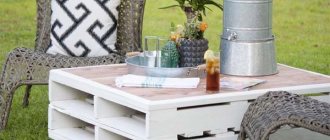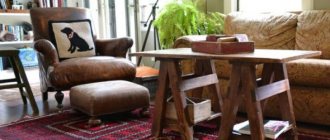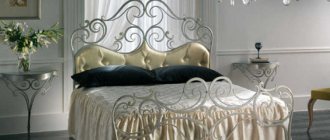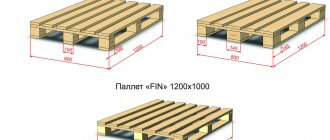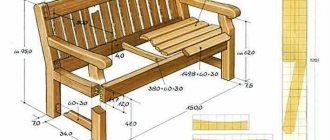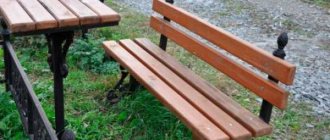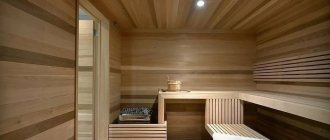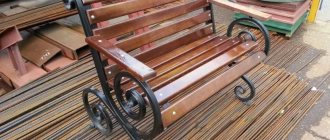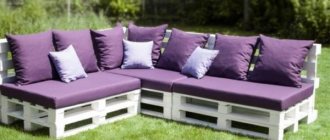Design Features
The bathhouse bench is characterized by certain distinctive features. Products used in rooms with high humidity levels must be of high quality, durable, and strong. Among the main design features are:
- high material density, ease of processing;
- low resin content in wood;
- low thermal conductivity;
- resistance to deformation when heated;
- compact sizes.
The surface of the bench comes into contact with human skin, so it is worth paying attention to its safety and environmental friendliness. The bench should not have protruding elements or sharp corners. Metal parts may cause burns. All wood elements are carefully sanded and treated with natural protective agents.
Bath benches cannot be coated with paints and varnishes. When temperatures rise, these substances release toxins, and moisture leads to rapid deterioration of the decorative layer. Mobile and built-in products are mounted against blank walls that do not have window openings, ventilation, or heating equipment. The optimal solution for a small bathhouse would be a corner model.
You cannot place the bench close to the wall; you must leave a small gap - about 10 cm.
High material density
Low thermal conductivity
Resistance to deformation
Compact dimensions
Bench for a bath: features of development and application
Benches for baths and saunas are used for both sitting and lying, so it is necessary to take into account the height and build of a person when designing them.
For a person of average height, the following dimensions of a bath bench are recommended:
- Bench for sitting: their width is within 40 cm, height 50 – 95 cm.
- Benches for saunas, on which they are placed in a semi-sitting position: at a height of 50 – 90 cm and a backrest height of 110 cm.
- Benches for lying down: the width of the structure should be 90 cm, with a height of 50 cm. Such benches are made without a footrest.
- The length of the bench per seated person is taken to be 90 cm. When using the bench by several people at the same time, the standard increases by 60 cm for each person.
- When making a bench, it is necessary to provide for an arrangement of the legs of the bench that will not allow it to tip over when there is a load on the edge.
When creating benches for a bathhouse, you must pay attention to the dimensions of the room and not clutter it with unnecessary furniture that interferes with movement.
Types and dimensions
The model and parameters are selected depending on the purpose and installation location of the structures. There are standard sizes of wooden benches for a bath:
- Bench for lying down. The height of the product reaches 50 cm, width - 90 cm. As for the length, 150 cm is enough for two people. If the number of vacationers is larger, another 60 cm is added for each of them.
- For sitting. The width of the structure is 40 cm. Such models are equipped with a backrest, so their height varies from 50 to 110 cm.
- For the sauna. Products with a width of 60 cm are optimal. The height will be the same as that of benches intended for sitting.
Types of wooden benches, their features, shapes and sizes
There is another type of bath benches - for the steam room. The surface length reaches 180 cm. The following types of products are distinguished:
- Single-tier. The sauna bench is suitable for any small space. Most often, this design is mobile.
- Two-tier. Installed in spacious steam rooms, designed for people of tall or average height. You can climb to the second level using an attached ladder.
- Three-tiered. Installed in large baths with high ceilings. The optimal distance between the lower and upper benches is 100 cm.
- Stepped. Used in small steam rooms. You can lie down on the upper bench; the lower bench is used for sitting or as a support when climbing onto the upper tier.
Multi-tiered benches are ideal for installation in a steam room. With their help, vacationers will be able to choose the optimal temperature regime for themselves. It is better to install a small mobile bench without a back in the dressing room or wash room.
When installing structures with several tiers, experts recommend making the upper levels removable and the lower ones fixed.
Single-tier
Bunk
Three-tier
Stepped
Types and purpose
Depending on the destination, bath benches have several types:
- Low, 50-70 cm high, without backs, most often placed in the sink. You can wash on them and use them as stands for basins, buckets and other attributes.
- Tall, several tiers. Such benches are installed in steam rooms. They can be with or without backs.
- Medium, often with armrests and soft upholstery. These benches will be used to equip a recreation area and a dressing room. They differ from the others in their larger width.
Material of manufacture
Bath benches are always made of wood, but not all types are equally good for these purposes. When making your own, you should give preference to materials that are characterized by strength, resistance to moisture and high temperatures:
- Linden. Reliable, durable wood, when heated, releases a pleasant aroma, as well as substances beneficial to the human body. The only drawback is the appearance of a dark shade due to constant contact with moisture.
- Cedar. Reliable, easy-to-process material, capable of absorbing small amounts of water. It has an attractive texture, a good smell, and is characterized by disinfecting properties.
- Larch. It lasts a long time, does not deteriorate under the influence of high humidity, but is expensive. A bench made of this material can be installed in any room of the bathhouse.
- Maple. Strong, durable wood that does not darken or crack with regular contact with water. The material has low thermal conductivity.
- Oak. Reliable, practical wood with a beautiful texture. A bench made from it will become a real decoration of the bathhouse. The disadvantage of the designs is their high cost.
- Aspen. Budget material that creates a special microclimate in the room. It does not last long and begins to rot due to high humidity. Such benches can only be used in dry rooms.
- Abashi. Exotic wood, the high cost of which pays off with a long service life, is resistant to heat and moisture, and durable.
- Birch. Heavy material with high density. It is characterized by strength and does not deform when exposed to negative factors.
Master classes on making simple benches for the garden with your own hands
You can make a bathhouse bench with your own hands from a variety of materials. Only deciduous trees are allowed in the steam room; coniferous trees produce smog when heated, which causes burns. For rooms with lower temperatures, benches made of larch and pine are suitable. These types of wood gain hardness and strength due to exposure to moisture.
Linden
Cedar
Larch
Maple
Oak
Aspen
Abashi
Birch
Processing methods
Wooden structures for baths are impregnated with special natural-based products. The use of oil-based varnishes and paints is unacceptable, since when heated they will smell unpleasant and release toxins. The following compounds will help protect benches from mold, fire, and rotting:
- Oils. The products protect wooden products in the steam room from moisture and do not form a film on the surface.
- Oil wax. Made from natural ingredients, used in washing and steam rooms. The composition does not emit toxic substances when heated strongly.
- Bleaches. Contain oxidizing agents that prevent the formation of a dark shade.
- Fire retardants. They are relevant if the sauna bench is installed next to an open fire or is operated at elevated temperatures. Such means prevent accidental fire of the product.
How to make a universal bench for your garden with your own hands
Before processing, the surface of the bench is thoroughly sanded and polished. The layers of wood are removed slowly and not too deeply. After this, the products are applied in 1–2 layers, and the bench is allowed to dry completely. It is recommended to carry out all procedures strictly according to the attached instructions.
Oils
Oil wax
Bleaches
Fire retardants
Making a bench for a bathhouse with your own hands: design options
There are many types of benches for a bath - stationary, movable, folding. For each bath room, specific benches are made, suitable only for a given place, shapes and sizes.
During bath procedures in the steam room, it is customary not to sit on a bench, but to lie down, and the number of lying places depends on the capacity of the room. Therefore, in order to increase the possible number of people steaming at the same time, benches of special systems are installed here.
Options for bath bench designs:
- A simple mobile bench without a backrest on two legs, used in the washing area, in the rest room or in the steam room, including as a footrest.
- A rustic-style bench with four legs is a strong, stable option for installation in a dressing room.
- A portable bench for a steam room, its length can be from 90 to 151 cm, width approximately 50 cm;
- Stationary single-tier shelf for the steam room. Its length is 150 - 185 cm and width 40 - 65 cm. The lower step should be at least 20 -25 cm from the floor for air circulation.
- Two-tier wall shelf for steam room. It is installed if the room is not very large.
- Three-tier shelf. The upper tier of shelves is made approximately 90 cm wide and 180 cm long, which allows an adult to sit comfortably. The distance from it to the ceiling should be at least 120cm. The lower shelves, 45–60 cm wide, are provided for seating.
- Folding benches that have a special mechanism for turning the seat into a vertical position and tightly fixing it to the wall. Allows you to increase the usable area of a small room.
- Portable benches with backs and armrests or trestle beds. Used in the rest room, installed near the table. They are usually large in size so that you can not only sit freely at the table, but also relax while lying down.
For the rest room, you can use furniture made of any wood and any design. The main thing is that it provides a comfortable and safe rest after the procedures.
Care Tips
Do-it-yourself bathhouse benches are regularly influenced by many negative factors. Proper care will help extend the life of products:
- systematic ventilation of the bathhouse will prevent the spread of mold and mildew;
- after each visit to the steam room, it is necessary to thoroughly clean and dry each item;
- If stains or dirt appear on the bench, you can remove them with a warm soapy solution; it is better to avoid chemical and aggressive detergents;
- from time to time the bathhouse is heated idle; it is enough to bring the temperature to 100 degrees to destroy all pathogenic bacteria;
- periodically the surface of wooden structures is treated with antiseptic agents;
- benches are regularly inspected for damage, rot, affected elements are removed and replaced with new ones.
If you are making a bathhouse bench with your own hands for the first time, you should follow the recommendations of experts. Each element is polished until the surface condition is ideal. The corners of the product are rounded to reduce the risk of injury. It is better to use wooden fasteners rather than metal ones.
Making a sauna bench with your own hands is not a difficult job, the main thing is to use high-quality materials and follow the technological features of the process. The simplest shop will turn out original thanks to its unusual decor. The designs look interesting, complemented by lighting, which helps create a light, relaxed atmosphere.
Systematically ventilate the bathhouse
Carry out thorough cleaning
Heat idle
Inspect for damage, rot
Care instructions
After visiting the bathhouse, all wooden surfaces are wiped to remove moisture.
In the evening, after using the steam room during the day, all rooms of the bathhouse are cleaned. Puddles and leaves from brooms are removed from the floor. To reduce humidity, ventilate the shower room, steam room, and dressing room. The remaining water in the room will prevent the drying of multi-tiered bench structures that cannot be taken out into the fresh air.
Sometimes it is necessary to steam a room without visitors, bringing the temperature to +100°C. This will destroy harmful microorganisms, traces of which are not yet visible on the surface.
Means of protection
Synthetic-based varnishes and paints should not be used for the protective coating of bathhouse benches. When it is hot, volatile substances evaporate from the surface and enter the human respiratory organs. There are compositions with natural ingredients that will protect wood from rotting in wet conditions, but will be safe for people.
They use antiseptics that can be used in baths and saunas, which should be indicated on the packaging. It is recommended to buy products from branded manufacturers Tikkurila, Senezh, Neomid, and other common brands.
Impregnations based on natural wax work effectively, repelling moisture from the wood area. The products do not pose a danger to humans at any temperature. Manufacturers give different recommendations on the frequency of treatment, but on average such impregnations are carried out once every 2 to 3 years.
